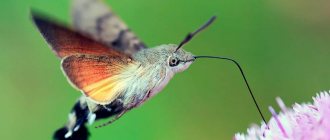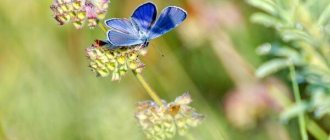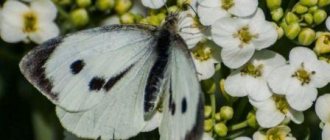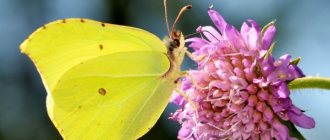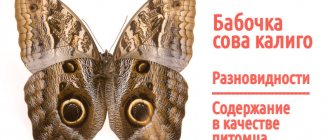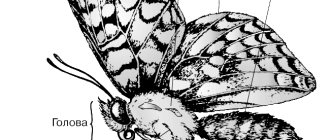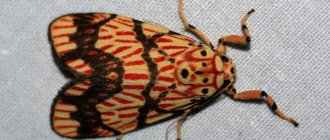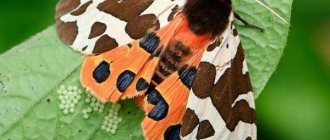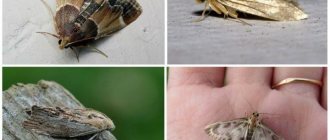Swallowtails or cavaliers are a family that unites the largest and most beautiful butterflies. The greatest diversity of species is found in the tropics, but interesting and colorful insects can also be seen on other continents. The family includes 700 species of swallowtails, 20 live in Russia. The swallowtail butterfly is a typical representative of the genus Papilio with long tails and wavy wings. The color of the insect is yellow with a black pattern and a red-blue eye. Despite the fact that the butterfly is found throughout the Palearctic, its numbers have declined sharply. To protect lepidoptera from complete destruction, the species was listed in the Red Book.
Morphological description
Swallowtail swallowtail (Papiliomachaon) is one of the most common representatives of its family. Carl Linnaeus named the species after the mythical Greek physician Machaon, who participated in the campaign against Troy. The size of the wings of the male is 65-80 mm, of the female - 75-95 mm. The main background of the wings is yellow. In the middle of the forewing there is a pattern of black stripes and spots, the base is darkened. Along the edge there is a wide black border with yellow hemispheres. The main part of the hind wings is yellow; closer to the edge there is a blue band with a black border. The outer edge has a red eye with a black outline. The photo shows that the edge of the hind wings of the swallowtail butterfly is wavy, the tails reach a length of 10 mm.
Information. Papiliomachaon of the first generation are light in color, representatives of the second generation are noticeably larger, their colors are richer and brighter.
The body of the moth is light-colored and covered with sandy hairs. There are longitudinal black stripes on the chest and abdomen. The head is round and inactive. On the sides are complex compound eyes. The organ of vision helps insects navigate in space, distinguish objects and some colors. In the frontal part there are long, segmented antennae ending in a club. Mouthparts are sucking type. This is a long black proboscis that allows it to drink nectar from flowers. In a calm state, it is twisted into a spiral.
Description of the swallowtail
Name: Machaon Lat.:
Papilio machaonClass: Insects - Insecta Order: Lepidoptera - Lepidoptera Family: Swallowtails - Papilionidae
| Habitat: | Europe, Asia, North and South America |
| Nutrition: | feeds on pollen, is not a pest |
| Spreading: | in the Red Book in some countries |
The name of the insect is associated with the ancient Greek healer Machaon.
Wing appearance
The wings are not always yellow; some butterflies are light or dark, depending on the species. They can be white with black veins drawn and light semicircles framed with black edging.
Hind wings
The hind wings have a wide blue or pale blue wave, which is limited by a black stripe below and above. On the part of the wing adjacent to the body there is a red-orange “eye”, which is surrounded by a black outline. The hind wings have flirty tails. Their length reaches 1 cm.
Corpuscle
The body has light hairs. The chest and abdomen are decorated with several black lines. The back is dark. A thick black stripe connects the head to the very bottom. Forehead with long ears, at the ends of which there are noticeable bumps.
Head and organ of vision
On the rounded and sedentary head, there are compound eyes on the sides. With their help, the swallowtail identifies objects and colors. They help you navigate well.
Size of individuals
The butterflies are quite large. The wingspan ranges from 64 to 95 mm. Size is also affected by gender. Males are smaller. Wingspan from 64 to 81 mm. In females – 74 – 95 mm.
Lifespan
The lifespan does not exceed 3 weeks. This is influenced by the area. Up to three generations may appear between spring and autumn. Most give no more than 2 generations. In the north there is a maximum of one. Flight falls from May to August, in Africa from March to November.
The pattern of the swallowtail is influenced by the date of appearance and the region of habitat.
In northern regions, the moth is pale in color, while in warmer regions they are brighter. The first generation does not have a bright pattern. The next generation has larger sizes and a brighter pattern.
Lifestyle
Swallowtail butterfly.
The activity of beautiful animals is observed on sunny and warm days. Moths settle on their favorite inflorescences and flowers. Nectar contains a huge amount of valuable microelements that swallowtail needs.
Usually the butterfly lives in parks, meadows and gardens. Males choose the dominant height. Males are united in a small group, a maximum of 15 individuals. They can be seen on the shore of the reservoir. Butterflies love hills and tall trees.
Swallowtails are beautiful in flight. The hind wings are hidden behind the front wings. Fully spread wings can be seen when the sun rises or rain falls. Thus, the insects quickly warm up and fly away. Open wings are a rare successful shot by a photographer.
Habitat
The butterfly can be found on almost the entire European continent. The exceptions are Ireland and Denmark. They can also live in Asia, North Africa and North America. In Tibet it can be found at an altitude of 4.5 km. Usually live in:
- steppes and dry limestone meadows;
Swallowtail.
- fallow land;
- tall grass and wet meadows;
- city parks and groves;
- orchards and tree plantations.
However, the insect can migrate and fly even into a metropolis.
Diet
The main food plant in the desert and steppe of Asia is wormwood.
In the middle zone, the swallowtail feeds:
- hogweed and carrots;
- dill, parsley, fennel;
- angelica, celery, caraway seeds;
- thigh.
In other regions, the diet consists of:
- Amur velvet;
- hairy ash;
- all types of whole leaf;
- alders
The adult drinks nectar and sucks it out using its proboscis.
Stages of development
| Stage 1 | The tiny round eggs are green-yellow in color. 4 – 5 days after laying, a larva (black caterpillar) appears, having light “warts” and a central white spot on the back. |
| Stage 2 | As it matures, the pattern becomes striated with soft green and black stripes dotted with orange. The larvae feed well. After 7 days they reach 8–9 mm. |
| Stage 3 | Caterpillars feast on flowers and ovaries, and sometimes on the leaves of food plants. The caterpillars hold on well and are not able to fall if the stem is cut and moved. |
| Stage 4 | At the end of development, he stops eating. The final stage is pupation. Becomes a pupa on the plant. The color of the pupa is affected by the season. |
The summer individual is colored yellow-green and development occurs within 3 weeks. Winter - brown, similar to fallen leaves. Warm weather promotes transformation into butterflies.
Natural enemies
Swallowtails are a source of food for:
- reed buntings;
- tits and nightingales;
- insectivores;
- large spiders.
Defense mechanism
The caterpillar has a defense mechanism. It is contained in a gland known as osmeterium. She is able to put forward orange splayed horns with an orange-yellow secretion that has a pungent odor.
This repellent method is appropriate for young and middle-aged larvae . Adults will not need iron. Osmeterium is effective in the fight against wasps, ants, and flies.
But the butterfly tries to resist the birds in a different way. In this case, the moth quickly begins to flap and flicker its wings in order to divert the attention of predators to the tails of the wings.
Population and distribution
This species is not in danger of extinction. The number is decreasing, the number of mature individuals is decreasing. However, the butterfly is common in the Mediterranean.
Entomologists have no information about the exact number of subspecies. Opinions differ on this issue. Some scientists claim that there are 37 subspecies. Others number 2 times less.
Subspecies
The wide distribution area of swallowtails has led to the formation of various subspecies, differing in color and size.
- P. m. bairdii is a black swallowtail butterfly native to North America. The dark shape is similar to the polyxene swallowtail. The main color is black. On the front wings there is a pattern of yellow strokes and spots located on a black border. On the hind wings, in addition to yellow and blue spots near the tails, there is an orange eye.
- P. m. ussuriensis - lives in Primorye and the Amur region, the group is characterized by large insect sizes. Females have a wingspan of 95 mm, and males have a wingspan of 85 mm. Insects are distinguished by their rich black and blue colors.
- P. m. hippocrates - a subspecies has settled in Japan and nearby islands, in which a blue stripe above a red eye is enclosed between two black ones.
- P. m. kamtschadalus are unique butterflies of bright yellow color with a faded black pattern and shortened tails. The endemic subspecies lives on the Kamchatka Peninsula.
- P. m. gorganus - continental subspecies is widespread on the plains of Russia, in the foothills of the Caucasus and Central Europe. What does the swallowtail butterfly, found in most European countries, look like? The wingspan does not exceed 60-70 mm, their tails are 6-7 mm long. The background of the wings is light yellow with a distinct black pattern and blue spots.
How does a swallowtail reproduce?
The butterfly's mating season begins in May. But depending on the region of residence, this time may vary - sometimes it happens in July, August or September. Mating occurs in the air, during the so-called mating flutters.
After mating has occurred, the female lays from one to three yellow eggs at a time. She is capable of reproducing up to 120 eggs per season. Caterpillars appear within a week. They are very beautiful and bright. Initially just black with white and red spots. Then they turn green, additionally orange and black stripes appear. They are very voracious and immediately after birth they begin to feed on leaves.
To protect itself from enemies, the swallowtail butterfly has a pair of glands on its head that are not visible if the caterpillar is in a calm state. But when there is danger, they turn into orange growths that spread an unpleasant, repellent odor around.
Later, like other butterflies, swallowtail caterpillars turn into pupae. Depending on the season they may have different colors. In summer they are greenish-yellow and develop within three weeks. In winter they are brown in color. During this period, the pupae develop over several months until constant warm weather arrives, when the fully formed butterfly can already fly without fear of cold weather and feed.
Appearance of the caterpillar
In May, the first generation swallowtail butterfly caterpillars appear. From the eggs they emerge black with many orange warts and a white area on the back. After several molts, the caterpillar becomes bright green with narrow black transverse stripes and orange spots on each body segment. The larva has three pairs of true legs on the thoracic segment and five pairs of pseudolegs on the abdomen.
The larva has a defense mechanism against enemies. This is the fork-shaped gland osmetria. It is located in the prothoracic segment and looks like orange horns. The secretions and smell of osmetria repel ants, wasps and flies. The larvae use it at an early age. It does not affect larger predators - birds. The caterpillars are hunted by tits, reed buntings, and nightingales. They destroy 40-50% of the offspring.
Keeping at home
To keep a moth in the house, you should prepare a 10 liter aquarium. At the bottom of the container you need to put a thick layer of paper that will absorb excess moisture. Also in the aquarium you need to place branches sticking out in different directions. On them the butterfly can spread its wings and the caterpillar can pupate.
To feed the insect, you need to prepare a honey solution in a ratio of 1:5. You need to moisten a cotton pad in it and place it on a saucer. After this, carefully hold the butterfly on your finger and use a toothpick to spin its proboscis so that it reaches the “nectar.” The moth should be fed once a day.
Contents in the apartment
Periodically you need to spray plain water from a spray bottle inside the aquarium.
The lifespan of the Swallowtail butterfly at home is 2 weeks.
When growing a moth from a caterpillar, you need to place a bunch of dill inside the aquarium and transfer the larva to it. Sometimes the greens should be sprayed with water and replaced with fresh ones. After 12 days the larva will pupate. In this case, all that remains is to wait for the moth to appear.
Related species
The Maak's swallowtail or blue swallowtail butterfly also belongs to the genus Papilio. The insect is named after R. K. Maak, a researcher of Siberia and the Far East. The wingspan of the largest butterfly in Russia is 125-135 mm. The color of the forewings of males has a green tint and black stripes. The hind wings are dark blue with blue spots. Females are brown or black in color; the hind wings have a pattern of red spots at the outer edge.
The Maaka tail-bearer lives in Primorye, Transbaikalia, Sakhalin, Korea, Japan and China. The insect lives in deciduous and mixed forests. Caterpillars feed on trees from the rue family - Amur velvet, Sakhalin velvet. The blue swallowtail is listed in the Red Book of the Sakhalin Region.
Butterfly feeding
Swallowtail feeds on the same thing as other butterflies, namely flower nectar. Adults do not need much food. The larvae, on the contrary, have a good appetite.
The main preferences of the Machaon caterpillar:
- parsley;
- angelica;
- dill;
- caraway;
- fennel;
- carrot;
- celery;
- thigh;
- hogweed;
- cutter;
- prangos;
- sagebrush;
- Japanese alder;
- Amur velvet;
- wholeleaf.
Before pupation, the larvae practically stop eating, since during development they accumulate a sufficient amount of nutritional components.
Japanese alder
Habitats and lifestyle
In describing the lifestyle of the swallowtail butterfly, a significant role is given to two points: nutrition and reproduction. In the short time allotted to the imago, they must gain strength for mating and continue the race. Favorite habitats: steppes with various herbs, well-warmed forest glades and edges, roadsides and river banks. In the northern regions it is found in the tundra. Some individuals fly into cities. In the mountainous regions of the Alps they fly to a height of 2000 m. Adults are prone to migration, flying considerable distances in search of comfortable living conditions and food plants.
Butterflies fly in temperate climates from May to August, in the south - from March to November. The bulk of insects give two generations, in the north one, in North Africa - three.
Reproduction
The fertilized female lays single eggs on food plants. In the middle zone these are umbelliferous: dill, parsley, angelica, mustard plaster, celery and cumin. In other regions, rutaceae, birch, and asteraceae plants are found. The laying is carried out on the lower part of the leaf or stem, while the butterfly hangs in the air. The female's fertility is 100-120 eggs. They are initially green in color, then become yellow-brown.
A week later, a caterpillar 3 mm long appears. In warm weather it feeds a lot and grows quickly. Prefers to eat ovaries and flowers, less often leaves. The caterpillar changes through 5 instars. The adult larva grows up to 50 mm. The development period depends on weather conditions, in favorable circumstances it is 15-18 days. Before pupation, the caterpillar stops feeding and looks for a suitable place.
For pupation, the stem of a food plant or a nearby bush is selected. The insect is attached to the branch with a silky belt. Summer pupae of the first generation are green. After 2-3 weeks, the imago emerges from them. Overwintering pupae are brown; this stage lasts throughout the entire cold period.
Nutrition
Sailboats fly actively in warm sunny weather. Adults need additional nutrition on flowers and replenishment of microelements. Male swallowtails often gather in groups of 10-15 individuals on the wet banks of water bodies and sit on excrement and dung. What does the swallowtail butterfly eat? The main feeding occurs on the flowers of herbaceous plants:
- carrot;
- snakehead;
- oregano;
- honeysuckle;
- rose hip;
- geranium.
Having fulfilled its intended reproductive function, the insect dies. How long does a swallowtail butterfly live? The lifespan of the imago is 3 weeks.
Reproduction and lifespan
With the onset of stable warmth in spring, butterflies begin their active summer, the purpose of which is to mate with a partner. Pairs are formed thanks to pheromones that females secrete to attract males.
Butterflies lay eggs one at a time, fixing them with a special secretion on the back of the leaves or on the stems of the plant. After 8-10 days, the caterpillars of the Swallowtail butterfly emerge from them and immediately begin to actively eat. As they grow, they molt three times and eat their old skin. The insect remains in the caterpillar stage for 10-12 days, after which it pupates.
The Machaon pupa remains motionless for 2-3 weeks, and then a butterfly emerges from it. The imago dries out its wings within the first few minutes. An adult is ready to breed offspring within 24 hours.
The Swallowtail butterfly lives only 20 days. During this period of time, the female lays 100-200 eggs. During the season, 2 generations of offspring appear. The second generation insect overwinters in the form of a pupa.
Limiting factors and protection
The number of swallowtail butterflies in Russia ranges from low to normal in different regions. The species is under threat in several regions: Smolensk, Moscow, Vologda. In these regions, as well as on Sakhalin, the swallowtail butterfly is listed in the Red Book. Negative factors affecting the number of butterflies are natural and economic. Natural problems:
- Low temperature, lack of sun during mating and ovipositor periods.
- Damage to larvae by fungus and parasites in a rainy, prolonged autumn.
- Early frosts, due to which the caterpillar does not have time to turn into a pupa and dies.
Anthropogenic factors:
- Forest fires and fallen grass.
- Insecticidal treatment of agricultural fields.
- Destruction of caterpillars and catching butterflies for collection.
A decrease in the number of Papiliomachaon is observed not only in Russia, but in European countries. The species is under state protection in Latvia, Lithuania, and Germany. As a precautionary measure, collecting butterflies and caterpillars is prohibited. In their habitats, the use of chemicals and grazing are regulated.
Nutrition
The habitat of these insects must necessarily contain umbrella plants because it is their nectar that is the favorite delicacy of swallowtail butterflies. Lately, not often, but you can still notice them on carrots, dill, fennel, hogweed, caraway, parsley, angelica and other plants.
Swallowtail caterpillars prefer to extract beneficial substances from wormwood, ash, and alder. For adult insects, sometimes it does not matter whether the plant is an umbrella plant or not, as long as it contains enough nectar, which they obtain with the help of a proboscis.
It is very important for caterpillars to be constantly fed, so their feeding process begins from the very first moment of their birth. With the end of the caterpillar's development, its appetite noticeably decreases.
Swallowtail butterfly: interesting facts
- In 2006, at the initiative of the German Nature Conservation Union, the swallowtail became a symbol of the country. In this way, people's attention is drawn to the plight of endangered species.
- The tails and eyes on the tips of the wings serve to distract the birds' attention from the vital organs of the insect.
- If a butterfly is disturbed, it begins to flap its wings sharply, trying to scare away the enemy with the flashing of bright colors.
- The moth can be found in the mountains of Tibet at an altitude of up to 4500 km.
- At the end of summer, the bright colors on the scales fade, and the pattern on the wings becomes faded and unclear.
- The intensity of the color of the wings depends on climatic conditions. The subspecies living in the northern regions have a sandy, almost white, main color. Insects in the south change their palette to a bright yellow hue.


